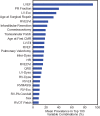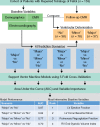Predicting deterioration of ventricular function in patients with repaired tetralogy of Fallot using machine learning
- PMID: 29538684
- PMCID: PMC6012881
- DOI: 10.1093/ehjci/jey003
Predicting deterioration of ventricular function in patients with repaired tetralogy of Fallot using machine learning
Abstract
Aims: Previous studies using regression analyses have failed to identify which patients with repaired tetralogy of Fallot (rTOF) are at risk for deterioration in ventricular size and function despite using common clinical and cardiac function parameters as well as cardiac mechanics (strain and dyssynchrony). This study used a machine learning pipeline to comprehensively investigate the predictive value of the baseline variables derived from cardiac magnetic resonance (CMR) imaging and provide models for identifying patients at risk for deterioration.
Methods and results: Longitudinal deterioration for 153 patients with rTOF was categorized as 'none', 'minor', or 'major' based on changes in ventricular size and ejection fraction between two CMR scans at least 6 months apart (median 2.7 years). Baseline variables were measured at the time of the first CMR. An exhaustive variable search with a support vector machine classifier and five-fold cross-validation was used to predict deterioration and identify the most useful variables. For predicting any deterioration (minor or major) vs. no deterioration, the mean area under the curve (AUC) was 0.82 ± 0.06. For predicting major deterioration vs. minor or no deterioration, the AUC was 0.77 ± 0.07. Baseline left ventricular (LV) ejection fraction, LV circumferential strain, and pulmonary regurgitation were most useful for achieving accurate predictions.
Conclusion: For the prediction of deterioration in patients with rTOF, a machine learning pipeline uncovered the utility of baseline variables that was previously lost to regression analyses. The predictive models may be useful for planning early interventions in patients with high risk.
Figures





Comment in
-
Machine learning for predictive analytics in medicine: real opportunity or overblown hype?Eur Heart J Cardiovasc Imaging. 2018 Jul 1;19(7):727-728. doi: 10.1093/ehjci/jey041. Eur Heart J Cardiovasc Imaging. 2018. PMID: 29538756 No abstract available.
References
-
- Apitz C, Webb GD, Redington AN.. Tetralogy of Fallot. Lancet 2009;374:1462–71. - PubMed
-
- Nollert G, Fischlein T, Bouterwek S, Böhmer C, Klinner W, Reichart B.. Long-term survival in patients with repair of tetralogy of Fallot: 36-year follow-up of 490 survivors of the first year after surgical repair. J Am Coll Cardiol 1997;30:1374–83. - PubMed
-
- Valente AM, Powell AJ.. Clinical applications of cardiovascular magnetic resonance in congenital heart disease. Magn Reson Imaging Clin N Am 2007;15:565–77. - PubMed
-
- Geva T, Sandweiss BM, Gauvreau K, Lock JE, Powell AJ.. Factors associated with impaired clinical status in long-term survivors of tetralogy of Fallot repair evaluated by magnetic resonance imaging. J Am Coll Cardiol 2004;43:1068–74. - PubMed
-
- Knauth AL, Gauvreau K, Powell AJ, Landzberg MJ, Walsh EP, Lock JE. et al. Ventricular size and function assessed by cardiac MRI predict major adverse clinical outcomes late after tetralogy of Fallot repair. Heart 2008;94:211–6. - PubMed
Publication types
MeSH terms
Grants and funding
LinkOut - more resources
Full Text Sources
Other Literature Sources
Medical

